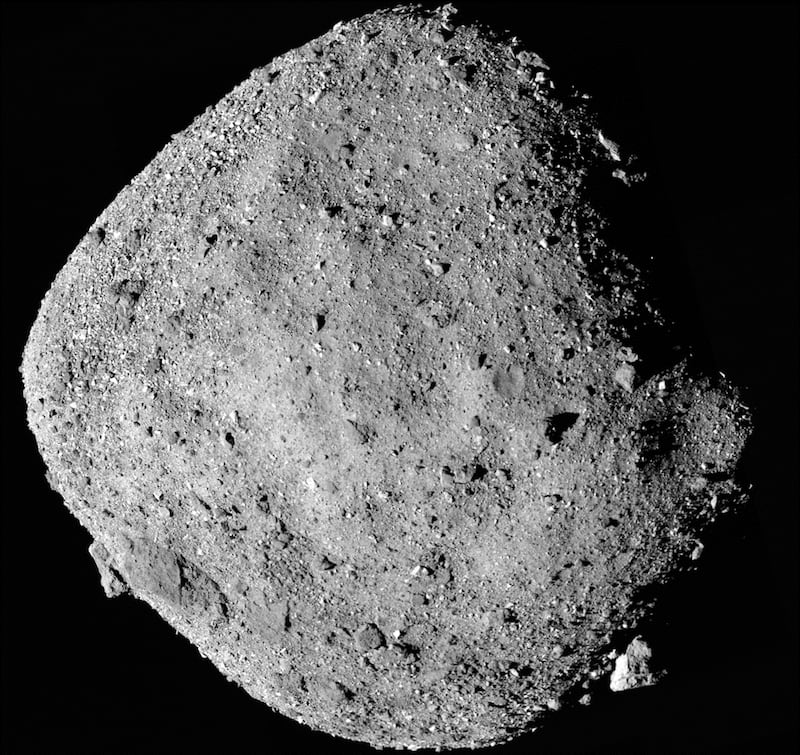Nasa will open a capsule containing asteroid samples as early as Tuesday after its historic Osiris-Rex mission saw the capsule land in the United States on Sunday.
The capsule, containing chunks from the asteroid Bennu that may hold clues to the solar system, landed in the Utah desert at 8.52am local time.
“This marks the US’s first sample return mission of its kind and will open a time capsule to the beginnings of our solar system,” Nasa said in a post on X, the website formerly known as Twitter.
The sample capsule was taken to a highly secured clean-room facility in Utah after its 1.9-billion km (1.2 billion-mile) journey from the asteroid. On Monday, the sample will be taken to Nasa’s Johnson Space Center, where it should be opened on Tuesday.
RM Block
The spacecraft launched in 2016 scooped up a large sample of rocks and dust from the near-Earth asteroid in 2020. This weekend, it passed Earth and sent the capsule to its landing spot in Utah.
Scientists were not sure exactly how much sample is in the container, but they suspect it is the most ever collected from an asteroid, weighing roughly 250 grammes (0.5 pounds). That will give them more rocks to analyse than ever before. The sample will help scientists get a snapshot of what materials were present when the solar system first formed.
Nasa administrator Bill Nelson hailed the mission’s success. “This mission proves that Nasa does big things, things that have inspired us, things that unite us,” he said.
The Osiris-Rex mission: An explainer
What is Osiris-Rex?
The Osiris-Rex spacecraft was launched by Nasa on September 8th, 2016. It collected a sample – roughly 250 grammes – of rocks and dust from the surface of the asteroid Bennu on October 20th, 2020.
After further study of the asteroid, Osiris-Rex set off back to Earth with the sample on May 10th, 2021. It is Nasa’s first mission to collect an asteroid sample.
How did the sample arrive back on Earth?
On Sunday, September 24th, the Osiris-Rex spacecraft released a capsule carrying the sample when it was 63,000 miles from the Earth’s surface.
The capsule pierce the Earth’s atmosphere travelling at about 44,500kph (27,650mph). Parachutes brought the capsule’s descent to a safe touchdown at a US government facility near Salt Lake City.
It was taken to a temporary “clean room” before being transported to Nasa’s Johnson Space Centre in Houston, Texas, on Monday.
What is Bennu, and why is the asteroid being studied?
Scientists predict that Bennu formed from pieces of a larger asteroid in the asteroid belt between one and two billion years ago. Bennu is relatively rich in organic molecules and appears to have been altered by liquid water in the distant past.
Scientists believe that asteroids like Bennu could have delivered these molecules and water through collisions with Earth, explaining why our planet now has an abundance of both.
Bennu’s rocks are unlike any found on Earth because factors such as weather and erosion have changed the planet.
As the asteroid crosses into the Earth’s orbit, it is also easier and quicker to send a spacecraft to Bennu and back than to the asteroid belt, which is between the orbits of Mars and Jupiter.
How will the sample be studied?
Once the sample has been documented and stored at the Johnson Space Centre, portions of Bennu’s rocks and dust will be distributed to scientists, other national space agencies and researchers around the world.
Up to a quarter of the sample will be distributed to 233 scientists on the Osiris-Rex team from 38 global institutions, including the University of Manchester and the Natural History Museum in London.
Some 4 per cent will be given to the Canadian Space Agency and 0.5 per cent to the Japanese state space agency, Jaxa.
Have other asteroid samples been returned to Earth?
Jaxa’s Hayabusa mission was the first to return samples, when it carried particles from the Itokawa asteroid in June 2010.
The Japanese space agency then successfully carried out a follow-up mission, Hayabusa2, with a sample from the Ryugu asteroid in December 2020.
What will happen to Osiris-Rex after it returns the sample?
Around 20 minutes after releasing the sample capsule above Earth, Osiris-Rex set out on a new mission called Osiris-Apex to explore asteroid Apophis, which it will reach in 2029. – Agencies



















